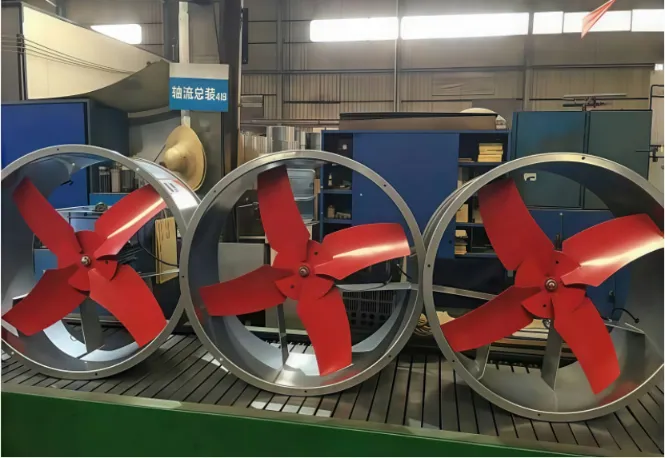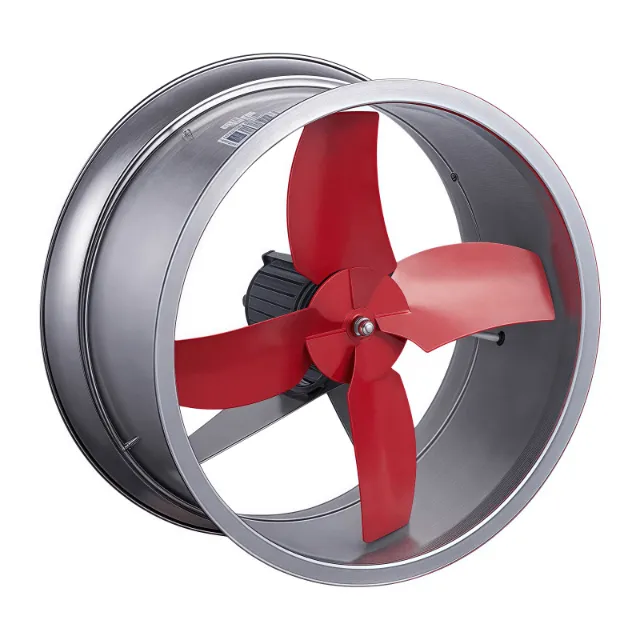How Blade Angle Affects Axial Flow Fan Efficiency

Introduction
Axial flow fans move air parallel to the shaft, common in factories, warehouses, and cooling systems. Blade angle plays a big role in how well these fans push air and use energy. This blog aims to guide engineers and facility managers on tweaking fan performance for better results.
Understanding Blade Angle in Axial Flow Fans
What is Blade Angle?
Blade angle refers to the tilt of the fan blades relative to the hub. It’s measured in degrees from the plane of rotation. Fans come with fixed angles, set during manufacturing, or adjustable ones that allow changes on the fly. Fixed types suit steady operations, while adjustable blades offer flexibility for varying needs.
Blade Angle vs Airflow
Tweaking the blade angle directly impacts air volume. A steeper angle pushes more air but ramps up resistance. Shallower angles move less air with smoother flow. This shift affects static pressure, which holds air in place, and dynamic pressure, which keeps it moving. Get it wrong, and the fan struggles. Daiho engineers provide precise blade angle calibration and customized fan designs to ensure maximum airflow efficiency in diverse industrial environments. Sometimes, folks overlook how small changes can boost output without extra power.
Blade Angle vs Energy Efficiency
Blade angle ties closely to motor load. Steep angles demand more power, spiking consumption. Optimal angles balance load, cutting energy bills. For example, in a warehouse setup, a suboptimal angle might waste 20% more electricity. Optimal ones, say around 30-40 degrees for many models, keep things efficient. Real world cases show fans running cooler and longer with right angles. It’s like tuning a car engine; skip it, and fuel efficiency drops.
Factors Affecting Optimal Blade Angle
Fan Design and Size
Single stage fans handle basic tasks, but multi stage ones stack blades for higher pressure. Larger diameters move more air, yet need careful angle settings to avoid turbulence. Blade count matters too; more blades often mean shallower angles for even flow. Smaller fans in tight spaces might require steeper pitches. It’s not one size fits all.
Operating Conditions
Heat and humidity alter air density, so blade angles must adapt. In hot, humid spots, steeper angles compensate for thinner air. Think HVAC systems in offices versus industrial vents in dusty factories. Cooling towers face water spray, which can foul blades if angles aren’t spot on. Environmental rules add another layer, pushing for efficient designs that cut emissions.
Airflow Requirements
Match the angle to needed volume and pressure. High volume setups, like ventilation in tunnels, favor moderate angles. Pressure heavy apps, such as drying processes, might need steeper ones. Calculate based on system demands to avoid underperformance. Over time, dust buildup can throw things off, so regular checks help.

Adjusting and Testing Blade Angle
Manual vs Automatic Adjustment
Manual tweaks involve stopping the fan and adjusting blades by hand, simple but time consuming. Pros: low cost. Cons: downtime. Automatic systems use variable pitch hubs that shift on command, great for dynamic environments. These mechanisms, often hydraulic or electric, respond to sensors. They shine in places with fluctuating loads, like seasonal factories.
Testing Efficiency
Measure airflow with anemometers, pressure via manometers, and power with wattmeters. Start with baseline readings, adjust angles, then retest. Tools like digital flow meters give quick data. Techniques include smoke tests for visualizing flow patterns. Daiho offers integrated testing, enabling clients to optimize blade angle settings and achieve reliable, energy efficient fan operation. Don’t forget safety gear during tests; sparks fly sometimes.
Practical Tips
Start with tiny adjustments, like 5 degrees, and monitor changes. Big swings can stress motors. Avoid over tightening bolts, which leads to vibrations. Clean blades first for accurate tweaks. In older fans, worn hubs might resist changes, so inspect those.
Common Mistakes and Troubleshooting
Misaligned blades often cause shakes or loud noises, cutting efficiency. Fix by realigning and balancing. Wrong angles shorten fan life through excess wear. One case: a plant set angles too steep, leading to bearing failure in months. Solution? Reset to manufacturer specs and add vibration monitors. Another issue: ignoring angle drift from thermal expansion. Regular audits catch this. Troubleshooting starts with logs; track performance dips.
Conclusion
Proper blade angles boost airflow, stabilize pressure, and slash energy use. Small tweaks yield big savings. With Daiho’s expertise in ventilation and cooling system design, clients benefit from precision engineered axial flow fans, customized blade angles, and advanced testing solutions to maximize performance and reliability. Test and optimize in your setup today for smoother operations.
FAQ
Q1: What is the ideal blade angle for an axial flow fan?
It varies by application, but 25-45 degrees often works for standard industrial use. Always check specs.
Q2: How often should blade angles be adjusted?
Every 6-12 months, or after major environmental changes. Monitor performance indicators.
Q3: Can wrong blade angles damage the fan?
Yes, they increase stress on components, leading to early failures like motor burnout.
Q4: What’s the difference between fixed and adjustable blade angles?
Fixed are set permanently for consistent ops; adjustable allow real-time changes for variable conditions.
Q5: How does temperature affect blade angle efficiency?
Higher temps thin air, so steeper angles might be needed to maintain flow.
